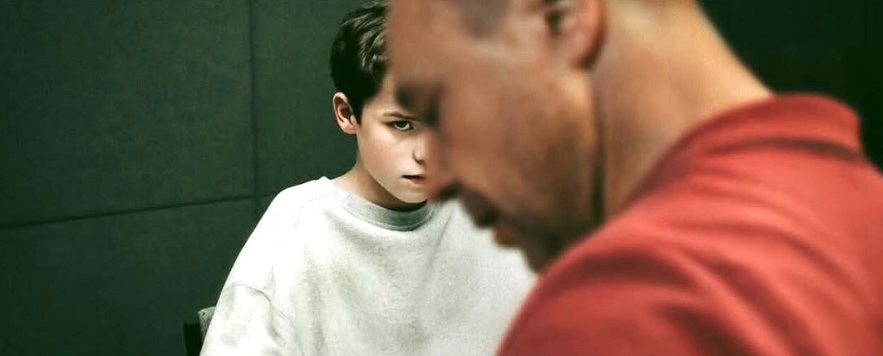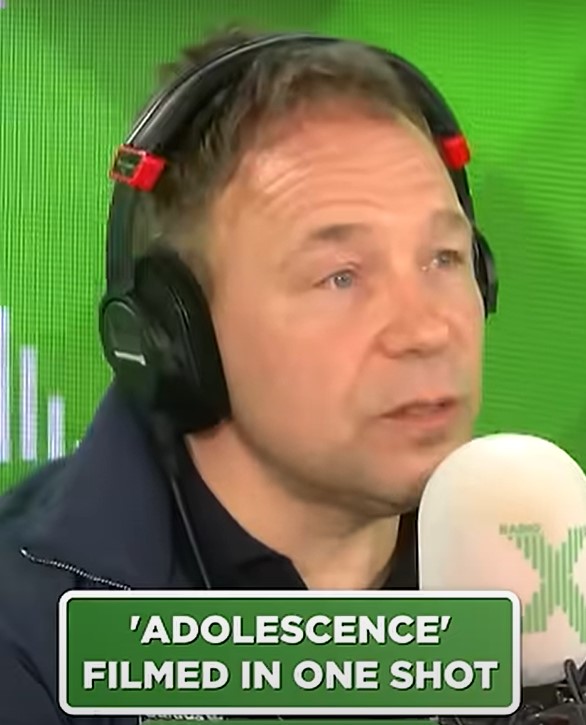 TV review: ‘Adolescence’…and how the system fails young people
TV review: ‘Adolescence’…and how the system fails young peopleBy Joe Langabeer
Ranking number one programme in the Netflix top ten at the moment is Adolescence, a gritty and disturbing drama, starring actor Stephen Graham who co-wrote the series with Jack Thorne. Thorne also wrote the recent Toxic Town series (reviewed here), but while Toxic Town was very explicit in its political messaging, Adolescence is far more subtle.
Although each episode is impressively shot in a single take, creating a theatrical feel, the show fundamentally explores misogyny and the state’s failure in safeguarding young people in contemporary society. Adolescence is an exhilarating series, currently ranking number one of all TV series in the UK, with Toxic Town following closely at number two.
The series revolves around the suspected murder of a thirteen-year-old girl, Katie, and the opening episode depicts a police raid, shockingly ending with the arrest of a thirteen-year-old boy, Jamie Miller. Viewers witness the police’s questionable interrogation techniques, including a strip search and intrusive questions about Jamie’s sexual interests. A solicitor provided by the police – since Jamie’s family cannot afford private representation, a poignant detail central to the series – suggests the severity of their methods implies overwhelming evidence against him.
For those interested in watching Adolescence, I recommend viewing the series first and returning to this review afterwards, although knowing certain plot points doesn’t diminish powerful themes. It is revealed at the end of the first episode that Jamie did indeed kill Katie, as CCTV captured him stabbing her multiple times, with the clothes matching his appearance in the footage.
Social media bullying
But subsequent episodes delve into Jamie’s motivations, driven by misogyny, feelings of isolation, and intense social media bullying – factors that warped his perceptions, leading him to believe he could commit murder without, because to his young age, fully understanding the consequences.
The programme doesn’t sympathise with Jamie; nor does it condemn him outright. Rather, it realistically portrays the complex experiences of young people today. In the second episode, detectives investigating the murder visit Jamie and Katie’s school, uncovering rampant bullying exacerbated by social media.
Katie’s taunting messages to Jamie, via Instagram, including emojis referencing “red pill, blue pill” from The Matrix, hint at accusations of incel behaviour. For context, involuntary celibates (incels) are part of a misogynistic movement that emerged prominently in the 2010s, where some men, feeling unable to form relationships, withdrew from women entirely, focusing instead on career and wealth accumulation. This mindset often fostered dangerous misogyny, leading to violent acts against women.
This issue remains prevalent today and is increasingly concerning. A Guardian article from a few years ago highlighted a significant rise in Prevent referrals involving young men drawn to ‘incel’ ideology and planning violent acts driven by their hatred of women. The report emphasised that this dangerous mindset continues to grow alongside broader online far-right ideologies, as social media platforms prioritise profit over content moderation.
Self-declared misogynist and ‘influencer’
The toxic influence of figures like Andrew Tate, an alleged trafficker, rapist, and notorious (and self-declared) misogynist, who promoted exploitation and subjugation of women through his online presence, further amplified these harmful attitudes among impressionable young men.
Despite society’s broad condemnation of Tate, social media companies, notably YouTube and TikTok, bear a heavy responsibility for amplifying his content through algorithms designed to maximise engagement, pushing short, misogynistic sound bites to millions of young viewers.
Interestingly, Thorne and Graham choose not to centre Tate explicitly, referencing his influence only briefly through comments by an adult character. This decision was clever, highlighting the fact that while mainstream media often pins blame solely on Tate, misogynistic attitudes predated and continue independently of him, particularly through social media platforms motivated purely by profit.

Stephen Graham interview on YouTube, speaking about the filming of the Adolescence series. Available here
In the third episode, Jamie’s mindset is further explored through sessions with a child psychologist. He doesn’t explicitly parrot Tate’s views, but reveals deep-seated misogyny and insecurity through his aggressive behaviour towards the psychologist. Jamie repeatedly describes himself as ugly and friendless, convinced he will never find love.
In a heartbreaking climax, as the psychologist concludes their sessions, Jamie is dragged away by security, desperately screaming to her, asking if she likes him. She does not answer – capturing a profound moment of vulnerability and despair for both the psychologist and the child.
Algorithms intensify misogyny
This raises the question of the role of social media and the mental effects it has had on young people. In a research report from University College London and the University of Kent, exploring how social media algorithms popularise misogynistic content online, various young people were interviewed.
It discovered that after only five days of using TikTok, there was a four-fold increase in the amount of misogynistic content recommended to users. Much of this content discussed how men were “lonely,” alongside depression, and the pressures men feel to succeed in life, with the algorithm then guiding users towards increasingly misogynistic tropes about masculinity and how to treat women.
The algorithm is exploitative – it isolates young people by amplifying feelings of loneliness, manipulating users into believing misogyny is a solution. This isn’t the user’s choice, but a predatory practice that must be stopped by making algorithms publicly transparent and monitored democratically by users and specialists, to prevent them from feeding young people further misery and despair.
You have to remember that TikTok, much like any other social media platform, is designed like a slot machine, continually simulating a gambling-like experience. You pull the lever (swipe your phone), hoping to find that one video or post providing satisfaction (what we call a dopamine hit). If you don’t, you keep swiping or scrolling until you do.
Huge profits generated for social media companies
In an excellent book, Addiction by Design, author Natasha Schüll describes how social media companies generate revenue through continuous, addictive consumption. The number of clicks and the time spent on their apps drive their profits. In this vicious cycle, young people become addicted to their phones, an intentional design of social media companies. The algorithms exacerbate loneliness and depression, often leading to radicalisation – all in pursuit of higher profits.
That is why Jamie says he’s lonely – because he is constantly told he is, then advised on how to “be a man” by channelling loneliness into rage and violence. The final episode focuses on Jamie’s family, who, thirteen months later, face the ramifications of having a son accused of murder. They endure harassment from a public divided between those who condemn Jamie’s actions and others who support him, due to conspiracy and misinformation.
It’s not until the final moments of the series that the themes fully crystallise. Jamie’s parents, excellently portrayed by Stephen Graham and Christine Tremarco, grapple with how this could have happened. They wonder if spending more time with Jamie could have prevented the tragedy.
Yet, it is clear that their demanding work schedules, necessary merely to survive financially, left little time for family interactions. Graham’s character anguishes over his perceived failures, recognising moments of embarrassment over Jamie’s poor football skills.
Despite these regrets, he was still an attentive father, and Jamie had a loving mother. The reality, however, is that the system was rigged against them from the start. With social media’s exploitative practices, parents working long hours to survive, and severe cuts to youth services and community support, it is no surprise young people turn to their phones – often their only available outlet for connection, in a world increasingly against them.
Overlooking effect of social media on women
I read an opinion piece by Vanessa Thorpe in The Observer, discussing the series. She argued we should stop alienating young men by dismissing their masculine energy, suggesting it should instead be channelled positively. This analysis, I felt, was shallow for two reasons: it offered no concrete solutions for channelling this energy, and it entirely overlooked the severe harm social media and technological developments have inflicted on women.
Excuse my cynicism, but get weary of the increasingly pervasive narrative claiming men that have been ‘alienated’ – a narrative I frequently see in the media. The reality is that, regardless of gender, all young people have been alienated by capitalism and the state.
Yes, young men have higher suicide rates, but young women are more likely to experience mental health issues. Numerous campaigns encourage young men to “speak up” about mental health and that is good, but equivalent support for women remains absent. Women are killed everythree days by men, usually partners, but sometimes sons.
Social media amplifies misogyny directed at women, while also driving harmful beauty standards and eating disorders. Ultimately, social media negatively affects everyone’s mental health. The real solution lies in having social media platform publicly owned and democratically managed by users, IT and mental health experts as well as government. Algorithms would, in effect be in the public domain; harmful content can be removed and stringent laws can hold social media platforms accountable for their practices.
But we must also give young people ways to depend less on social media. They need better jobs offering genuine skills and leading to economic independence and stability. We should provide more apprenticeships with fair wages, allowing young people meaningful career options, instead of forcing just them into unwanted university courses or dead-end jobs.
These examples underscore that the only true solution to the crisis facing young people is socialism. While Adolescence doesn’t call for this, the social and psychological landscape it describes calls out for it. Socialism is the essential reality needed to give young people their futures back.
 TV review: ‘Adolescence’…and how the system fails young people - By Joe Langabeer Ranking number one programme in the Netflix top ten at the moment is Adolescence, a gritty and disturbing drama, starring actor Stephen
TV review: ‘Adolescence’…and how the system fails young people - By Joe Langabeer Ranking number one programme in the Netflix top ten at the moment is Adolescence, a gritty and disturbing drama, starring actor Stephen The crisis in the universities - By Joe Langabeer Recently, I read a review of Bad Education by Matt Goodwin on a blog from the Higher Education Policy Institute. For those
The crisis in the universities - By Joe Langabeer Recently, I read a review of Bad Education by Matt Goodwin on a blog from the Higher Education Policy Institute. For those Youth services decimated over the years - By Joe Langabeer, Hastings and Rye Labour member The Children’s Commissioner for England, Rachel De Souza, noted in a recent report, that that those young
Youth services decimated over the years - By Joe Langabeer, Hastings and Rye Labour member The Children’s Commissioner for England, Rachel De Souza, noted in a recent report, that that those young The modern working class in Russia – part one - In this fascinating article from inside Russia, “SERGEI” gives us a valuable insight into the mood of Russian workers and, in particular, looks at the
The modern working class in Russia – part one - In this fascinating article from inside Russia, “SERGEI” gives us a valuable insight into the mood of Russian workers and, in particular, looks at the Report from UNISON young members’ conference - By Sjaan Heemskerk, UNISON Essex, personal capacity A lot of the UNISON Young Members conference in Swansea last weekend seemed to consist of a radical
Report from UNISON young members’ conference - By Sjaan Heemskerk, UNISON Essex, personal capacity A lot of the UNISON Young Members conference in Swansea last weekend seemed to consist of a radical

